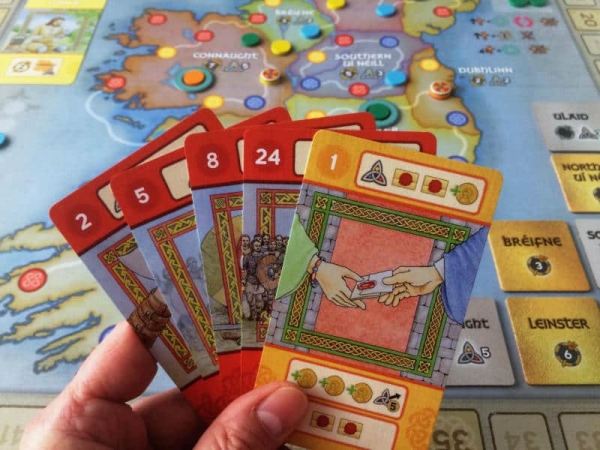Most of the earliest card games were trick-taking games played in the 800s in China. These will have felt quite different to our modern eyes. They didn't have the concept of trump cards or trump suits. There was also no bidding. Trumps were added to European card games in the 1400s, followed by bidding in the 1600s. It took another 100-200 years for familiar trick-taking games like Whist and Skat to appear. A few hundred years after that, the mechanism has now found a new lease of life in modern hobby games.
Trick-Taking Games and Me
I am a great fan of trick-taking games, even though I rarely get to play any. Unfortunately, not many people I know have grown up with trick-taking games as I have. The concepts of following suit, trumps and bidding are second-nature to me. I can usually read what information another player signals to me when they play a specific card at a specific point in time. Trick-taking is a world filled with subtle clues, planning ahead and perfect timing. There is almost as much depth and reading your opponent as there is in Chess.
It also doesn't help that pretty much all traditional trick-taking games require a specific number of players. Additionally, they are competitive or team games, which makes it harder to teach, unless you play your first games completely open. It takes a long time to learn what trick-taking actually means in detail. Even picking up what following a suit means and understanding why trump cards can't follow suit can take a while. So you'll be playing with open hands for a good few games before anyone will be comfortable playing on their own.
Luckily, modern trick-taking games have taken the genre to completely new heights. They have introduced new formats for playing and sometimes tweaked things until they have become unrecognisable. Trick-taking has also found its way into other games as just one mechanism among many.
Variable Player Counts
Addressing the problem of requiring a specific number of players is probably the biggest step forward, if you ask me. I can now take a trick-taking game to game night without having to worry about how many people will be there or will want to play the game with me. Skull King is probably the best example of a trick-taking game that can be played with a very wide range of player counts. Anything from two to six people will work equally well.
Not only that, but Skull King also doesn't have the difficult bidding phase found in other games, such as Skat. Everyone still bids on how many tricks they think they'll win, but that's about it. There are also no trump cards as such. There are special cards instead, but their function tends to be quite obvious, given the game's pirate theme. All you have to worry about is following suit, meaning you have to play the same colour as the first coloured card that was played. If you don't have that colour, you can play a different card. Finally, everyone just starts with a single card to play. In the second round, everyone gets two cards, followed by three in the third and so on.
Skull King makes trick-taking a lot easier to understand, while still keeping enough of the traditional concepts so players slowly learn what the genre is all about. It really opens up the genre to a much wider audience. People will pick up concepts such as playing to your strong suit and reducing smaller suits while playing. There is no big teach necessary. I don't even think you need to play with open hands, but if you do, you only reveal one or two cards to start with.
 (Photo courtesy of Schmidt Spiele)
(Photo courtesy of Schmidt Spiele)
Cooperative Trick-Taking
The other hurdle to getting into trick-taking is that some people don't much like competitive games, especially if there are only two of you.
The Fox in the Forest: Duet is the answer here. It's a two-player cooperative trick-taking game. It doesn't have trumps, but you do have to follow suit. Additionally, cards have a special ability that can help you win or stop you from losing at least. It's a good game to play with someone who is still learning about trick-taking. You don't necessarily have to play with open hands to learn the game. However, you can decide to openly talk about what you're trying to do. That way one player can teach the other why they played a certain card at a certain point and what they're hoping the other player to play.
If you want a cooperative trick-taking game for more than two players, then The Crew: The Quest for Planet Nine is the game for you. It goes up to five players, but you can also play it with just two. There will be a straw player if there are only two of you, but I think it works really well. My wife and I enjoyed playing it that way. However, the game really shines at a higher player count. Again, you don't necessarily have to play open. Just saying why you played a certain card will probably be enough for everyone to learn about the language of trick-taking games.
Trick-Taking and More
One game takes trick-taking in a very interesting direction. In Cat in the Box, there are no suits. Instead, when you play a card, you assign it one of the possible four suits. You record the fact on the shared game board. Now, nobody else can play that number in that suit. So if you played a two and said it was of the green suit, nobody else can now play a two and also claim it's green. The problem is, there are only four suits but every number appears in the deck five times. That means at some point someone won't be able to play their card. It's crazy but really works.
Of course, trick-taking is also just a mechanism or a set of mechanisms, as well as a genre. So it's no surprise that it has been put together with other mechanisms into one big game.
My favourite example here is Brian Boru: High King of Ireland. Trick-taking is what drives turn order and what actions players can carry out, but the rest of the game is a mix of area control, moving up certain tracks and having the most influence in various areas. It's a really interesting way to replace action selection with something that is a lot more subtle and traditional.
Mori is another game that is taking trick-taking to another level. It adds dice rolling into the mix. These dice sort of add to the suits and numbers in your hand. I can't quite work out how this is going to all fit together, but I'm quite excited to see other mechanisms being added to trick-taking to create something new and different.
 A hand of cards in Brian Boru: High King of Ireland
A hand of cards in Brian Boru: High King of Ireland
What About You?
I am sure there are many more types of trick-taking games that I haven't mentioned in this article. Can you think of any that you think should be mentioned? Are there any trick-taking games you really like? What are they and why do you like them so much? Maybe you're new to trick-taking. Do you have any tips for newcomers you want to share? As always, please share your thoughts in the comments below. I'd love to know what trick-taking games you like.
 Games
Games How to resolve AdBlock issue?
How to resolve AdBlock issue? 
















